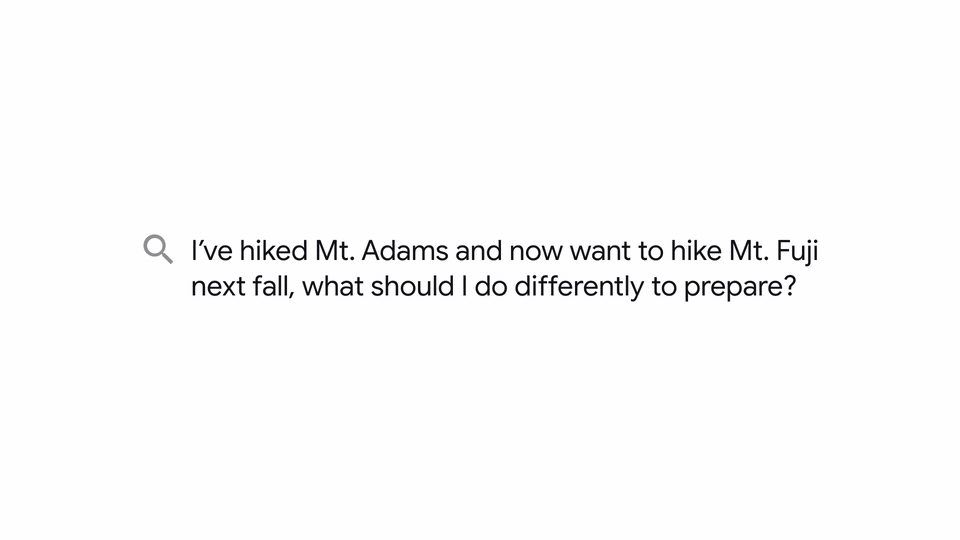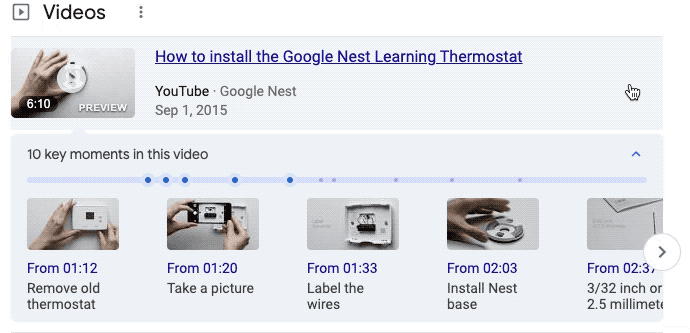In this month’s Google algorithm and search industry updates post, we explore:
- The news that the upcoming June Google Page Experience update will apply to desktop search results as well as mobile;
- Google’s announcement of a new query-processing technology called MUM (Multitask Unified Model);
- A statement from Google’s John Mueller that there’s no need to worry about using JavaScript on a site from an SEO perspective;
- Google releases Video SEO best practices for ecommerce
- Google expands its shopping integrations to include retailers on WooCommerce, GoDaddy and Square
As usual, we’ve organised these updates in terms of their significance using our traffic light system – a red light indicates a significant update that you should look into, a green light is for news that is less of an immediate priority, and amber is in between.
Read on for the latest news and updates in the search industry.
Google Page Experience update to apply to desktop results

You’ve probably heard about Google’s upcoming Page Experience update, which will see the Core Web Vitals become part of the ranking algorithm from June 2021 (if you need a catch up on this, watch the Core Web Vitals webinar delivered by Charlie Norledge, one of our technical SEO specialists).
Previously, it was thought that this update would only affect rankings in mobile search results. At the Google I/O conference towards the end of May 2021, it was announced that the Page Experience update will also apply to desktop results.
Jeffrey Jose, product manager at Google Search, explained:
“Today I am happy to announce that we are bringing Page Experience ranking to desktop. While we’re launching Page Experience on mobile soon, we believe Page Experience is critical no matter the surface the user is browsing the web. This is why we’re working hard on bringing Page Experience ranking to desktop. As always we’ll be providing updated guidance, documentation, and tools along the way to help your pages perform at their best. Stay tuned for more details on this.”
It’s not yet known how the update to desktop results will work and whether or not it will apply in the same way as on mobile. Judging by the announcement, it sounds as though more details will be released shortly – check back in here for next month’s update to learn more.
What does this mean for me?
This doesn’t change how you should approach the task of improving your site’s Core Web Vitals scores. If pages on your site are currently rated as ‘poor’ or ‘needs improvement’ for Largest Contentful Paint (LCP), Cumulative Layout Shift (CLS), or First Input Delay (FID), you’ll still need to work on these as part of your SEO activity.
That said, the announcement makes it all the more important to focus on this area of your site’s performance. Whilst previously we’d thought that any changes to rankings would be confined to mobile results, we now know that the impact will be felt across all search results.

MUM (Multitask Unified Model) – Google’s new query-processing technology

Another key announcement at the Google I/O conference was the unveiling of a new query-processing technology: MUM (Multitask Unified Model). When it is rolled out in the future, MUM will enable Google to answer increasingly complex search queries, reducing the number of searches required for a user to get a solution to their problem.
To help us understand how this new technology works, Google gave the example of the following scenario:
You’ve hiked Mt. Adams. Now you want to hike Mt. Fuji next fall, and you want to know what to do differently to prepare. Today, Google could help you with this, but it would take many thoughtfully considered searches — you’d have to search for the elevation of each mountain, the average temperature in the fall, difficulty of the hiking trails, the right gear to use, and more. After a number of searches, you’d eventually be able to get the answer you need.
But if you were talking to a hiking expert; you could ask one question — “what should I do differently to prepare?” You’d get a thoughtful answer that takes into account the nuances of your task at hand and guides you through the many things to consider.
As the video shows, MUM will be able to understand the importance of the various elements in a query like ‘I’ve hiked Mt. Adams and now want to hike Mt. Fuji next fall, what should I do differently to prepare?’
In response, this technology could advise on a range of relevant issues such as the training you’d need to do for the terrain and the hiking gear you’d need for Mt. Fuji at that time of year. Where previously it would have taken multiple searches to access all of this information, MUM will be able to provide all of the answers you need in one go.
Another type of Transformer architecture, this technology is similar to BERT but is said to be 1000 times more powerful – both advancements enhance Google’s ability to understand queries, but MUM also generates responses and is trained across 75 different languages. As a result, it will be able to provide answers to queries using content in other languages.
Taking things one step further, MUM is multimodal. This means that the technology can understand information across both text and images (and, in the future, it may even grow to work with other modalities such as audio and even video).
To return to the hiking query scenario, you’d be able to take a photo of your boots and ask “can I use these to hike Mt. Fiji?” MUM would understand the image and advise you that the boots would be fine for hiking in those conditions, as well as pointing you in the direction of a blog with a list of recommended gear.

What does this mean for me?
Whilst it’s exciting to hear about developments like this, Google has stated that MUM won’t be applied to search for quite some time yet. Moreover, when the new technology does come into play, its impact will be to improve the experience for users (no action will be required from site owners).
Google: no SEO issues with using JavaScript on your site

In the latest episode of the Search Off the Record podcast with Google’s Martin Splitt, John Mueller, Gary Illyes, and Daniel Waisberg, John and Martin discussed their use of Hugo, an open source static site generator (SSG), and John asked whether JS was a concern for SEO.
Martin Splitt replied:
“There’s nothing that is fundamentally different between JavaScript generated content and static content, except for when there’s edge cases, and we can’t see content that is generated by JavaScript.”
Google has come on leaps and bounds with its JavaScript rendering so this is positive news. However, site owners should follow JavaScript SEO best practices and avoid using JavaScript to toggle content visibility (i.e. hiding content behind a button where a user would have to reveal it in order to render the content).
What does this mean for me?
With the consistent rise of JavaScipt-based SSG’s like Hugo and Eleventy, content production is changing. While it’s good to see the use of JS isn’t an issue from an SEO perspective, Martin’s comments remind us that it can be a user experience concern if it’s used to obscure content.
You should also avoid relying too heavily on JavaScript for main functionality, where HTML/CSS will do the same job for a fraction of the code. To learn more about JavaScript, see our guide to JavaScript SEO.
Google releases Video SEO best practices for eCommerce

Google has released best practices for optimising video content for ecommerce sites. Videos can now appear on the main Google Search results page as well as the videos tab, and can highlight key moments in the video, which allows users to navigate your video, like chapters in a book.
In the update, Google highlights how the use of video on eCommerce sites can create deeply engaging experiences for shoppers and encourages utilising video in a number of ways across your eCommerce site. This includes using video on product pages to provide richer information to the user, on articles and blog posts and also live streaming videos – which allows viewers to interact with the host and form deeper relationships with customers. In the update, Google highlights how the use of video on eCommerce sites can create deeply engaging experiences for shoppers and encourages utilising video in a number of ways across your eCommerce site. This includes using video on product pages to provide richer information to the user, on articles and blog posts and also live streaming videos – which allows viewers to interact with the host and form deeper relationships with customers.

Google also provides tips on how to get the most out of search and discover, including things such as using video structured data, creating dedicated video pages to house your video, creating a video sitemap file and using structured data to enable LIVE badges when live streaming to help draw attention to streams when they go live.
What does this mean for me?
Ecommerce businesses should be utilising video to form stronger and deeper relationships with shoppers. Consider how you can incorporate video content on your website to help users understand more about how your products work and provide a better experience and also increase the probability of your videos appearing in featured snippets.
Google expands its shopping integrations to include retailers on WooCommerce, GoDaddy and Square

Google has launched partnerships with Shopify, WooCommerce, GoDaddy and Square to enable retailers on those platforms to list their products for free on Google.
This includes consolidated buying options so that when customers discover a product on Google, they’ll be shown a summary of all the purchasing options offered by the seller. This can include purchasing via the retailer’s site, picking up the item at a nearby location or Google’s native checkout flow.
What does this mean for me?
More merchants that use these eCommerce platforms will be able to show their products on Google for free. In addition to benefiting retailers, these new partnerships will also help users to better discover what they’re looking for. Showing more relevant, organic product listings across Google can help solidify the search engine as a shopping tool for consumers and could, in turn, help with boosting sales for merchants.






